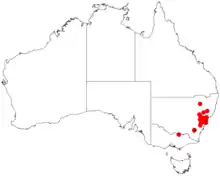Acacia lunata
Acacia lunata, commonly known as lunate-leaved acacia, is a shrub of the genus Acacia and the subgenus Phyllodineae that is endemic to eastern Australia.
| Lunate-leaved acacia | |
|---|---|
| Scientific classification | |
| Kingdom: | Plantae |
| Clade: | Tracheophytes |
| Clade: | Angiosperms |
| Clade: | Eudicots |
| Clade: | Rosids |
| Order: | Fabales |
| Family: | Fabaceae |
| Clade: | Mimosoideae |
| Genus: | Acacia |
| Species: | A. lunata |
| Binomial name | |
| Acacia lunata | |
 | |
| Occurrence data from AVH | |
Description
The shrub typically grows to a height of 1 to 3 metres (3 to 10 ft) and has a spreading habit and glabrous branchlets with phyllodes that have an inequilaterally oblanceolate to narrowly elliptic shape. The racemose inflorescences occur prolifically in the upper axils. The spherical flower-heads have a diameter of 5 to 6 mm (0.20 to 0.24 in) containing three to five loosely packed bright golden flowers. The firmly chartaceous to thinly coriaceous seed pods have a narrowly oblong shape with a length of up to 6 cm (2.4 in) and a width of 7 to 8 mm (0.28 to 0.31 in). The pods contain dull black seeds that are arranged longitudinally with an ovate shape and a length of 4 mm (0.16 in).[1]
Taxonomy
The species was first formally described by the botanist Conrad Loddiges in 1819 as a part of the work The Botanical Cabinet. It was reclassified as Racosperma lunatum by Leslie Pedley in 2003 then transferred back to genus Acacia in 2006.[2]
Distribution
It is native to an area of New South Wales from around Cessnock in the north down to around Richmond in the south on slopes and around creeks in sandy sandstone based soils as a part of open Eucalyptus woodland communities.[1]
See also
References
- "Acacia lunata". World Wide Wattle. Western Australian Herbarium. Retrieved 21 June 2019.
- "Acacia lunata Lodd., G.Lodd. & W.Lodd". Atlas of Living Australia. Global Biodiversity Information Facility. Retrieved 18 August 2019.